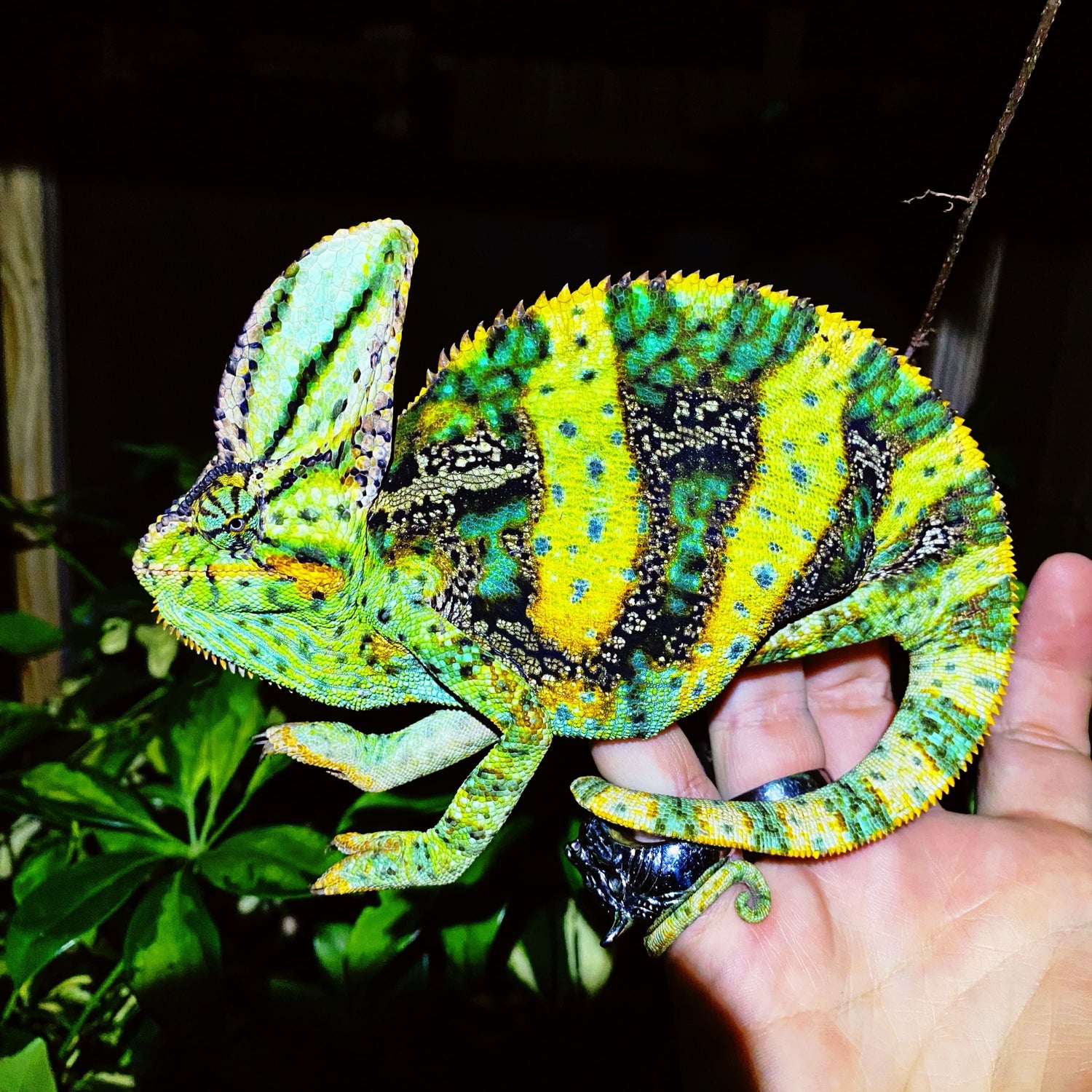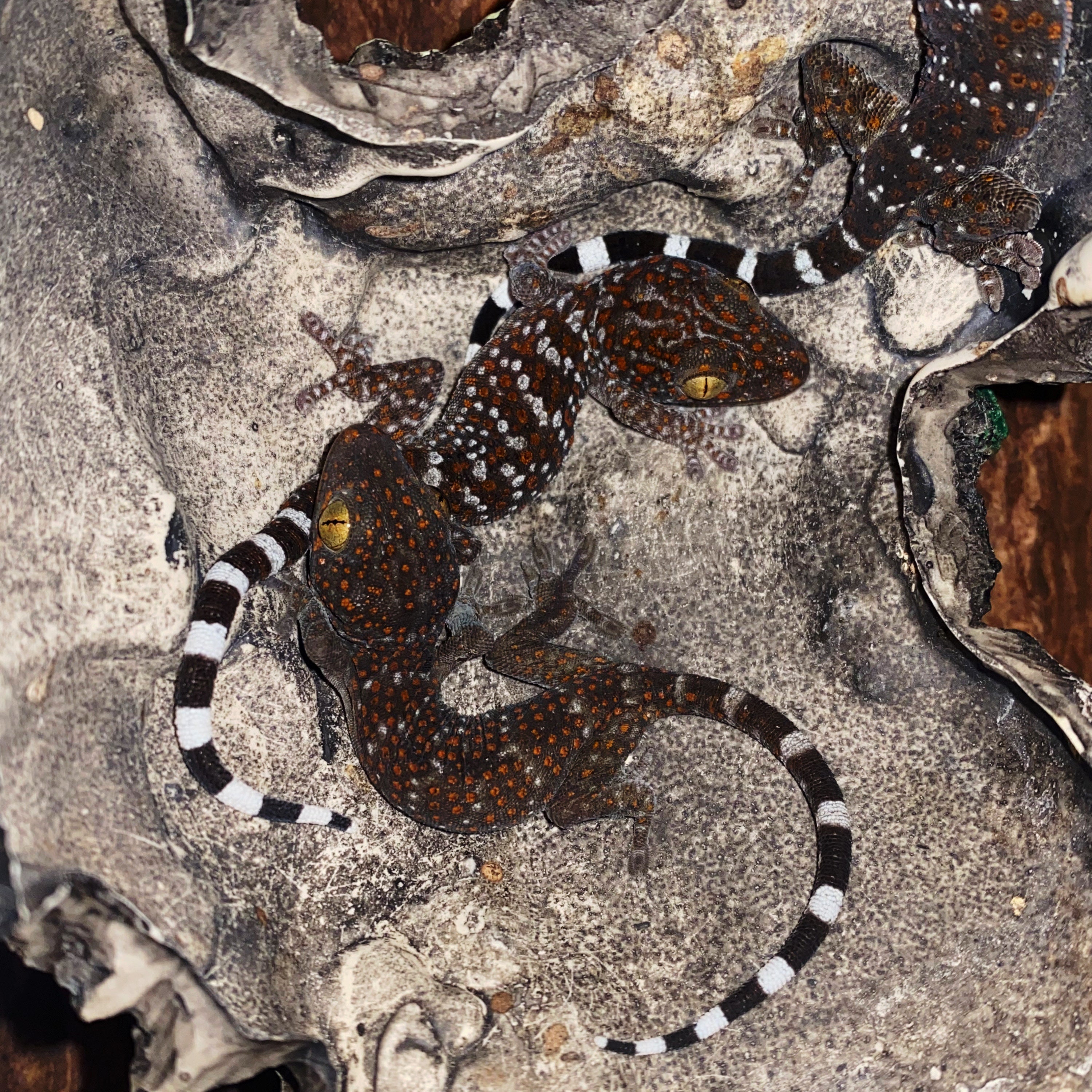Veiled Chameleons (Chamaeleo calyptratus) are some of the most recognizable reptiles in the exotic pet world, thanks to their striking crests, independently rotating eyes, and, of course, their ability to change color. But this ability isn’t just a party trick—it’s an intricate survival tool rooted in complex biology and fine-tuned by millions of years of evolution.
Let’s unravel the science behind how Veiled Chameleons change color, what it means, and why it’s far more than just camouflage.

The Myth vs. The Science of Chameleon Color Change
Contrary to popular belief, chameleons don’t change color to blend in with every environment like some reptilian shapeshifter. While camouflage does play a role, the real reasons are far more nuanced—and fascinating. Veiled Chameleons change color in response to their mood, emotional state, temperature, the presence of other chameleons, and environmental light conditions. Their color change is essentially a form of non-verbal communication and physiological adaptation, used to navigate social dynamics, regulate body temperature, and signal intentions.
How Do Veiled Chameleons Change Color?
It’s not pigment swirling beneath the skin and it’s certainly not magic. The secret lies in nanocrystals embedded in a layer of specialized skin cells known as iridophores. These nanocrystals have the unique ability to manipulate how light reflects off the chameleon’s skin. By adjusting the spacing between these crystals, the chameleon can control which wavelengths of light are reflected, resulting in an almost instantaneous change in visible color.
When a Veiled Chameleon is relaxed, the nanocrystals are tightly packed together, which causes them to reflect shorter wavelengths of light—primarily blues and greens. But when the chameleon becomes agitated, excited, or needs to make a statement, those nanocrystals spread apart. This change in spacing reflects longer wavelengths of light, shifting the skin’s color to warm hues like red, yellow, and orange. This physiological adjustment can happen in just a matter of seconds, allowing the chameleon to adapt its appearance almost in real-time.
What Do the Colors Mean?
Veiled Chameleons are essentially walking billboards of emotion and intent. Each shift in hue conveys a different message to the outside world. When displaying bright yellows and oranges, a chameleon is often signaling excitement, dominance, or even aggression. These colors frequently appear during male confrontations or when a male is trying to assert himself in the presence of another. Darker colors such as deep browns or near-black tones may indicate stress or fear, and in captivity, these colors can be a warning sign that something is wrong with their environment or health.
Paler shades, including whites and soft grays, often appear during shedding, but can also signify submission or a desire to cool down. A vibrant green with hints of blue typically signals a relaxed and healthy chameleon, often seen while basking or exploring its territory. Some Veiled Chameleons may even exhibit bold turquoise or aqua tones when feeling especially confident or when trying to impress a potential mate. These changes are not random—they’re precise, intentional signals exchanged between individuals or broadcast to the environment.

How Color Change Helps in the Wild
In the wild mountain slopes and arid scrublands of Yemen and Saudi Arabia, where the Veiled Chameleon originates, the ability to change color is more than a visual spectacle—it’s a critical survival adaptation. One of its most practical uses is thermoregulation. As cold-blooded creatures, Veiled Chameleons depend on external heat sources to control their body temperature. When they need to warm up, they darken their skin to absorb more sunlight. When they need to cool off, they lighten their skin to reflect it. This biological switch helps them stay within an optimal thermal range throughout the day.
Color change is also their primary mode of communication. Since they don’t use vocalizations like many other animals, they rely on their ever-shifting skin tones to convey emotion and intent. A sudden change in coloration can warn rivals, attract a mate, or signal submission. This silent language reduces the need for physical confrontation and streamlines social interaction.
Camouflage still plays a role, though it’s used more strategically than constantly. Subtle shifts in greens and browns help Veiled Chameleons blend in with foliage when necessary, offering some level of protection against predators. But unlike other animals who remain camouflaged at all times, chameleons know when to put on a show and when to fade into the background.
Their dynamic skin also gives them a tactical advantage. In an environment where staying still and hidden one moment, then flashing a warning the next, can be the difference between survival and defeat, color change provides both defense and offense. It allows them to conserve energy, avoid unnecessary fights, and remain in control of their surroundings.
Color Changes in Captivity: What to Watch For
When keeping a Veiled Chameleon in captivity, understanding their color language is one of the best tools a keeper can have. A vibrant, colorful chameleon is generally a sign of good health, proper husbandry, and a comfortable environment. On the other hand, a dull, dark, or discolored chameleon may be stressed, sick, or experiencing incorrect temperatures, humidity, or lighting.
During shedding, it’s common for their skin to take on a ghostly white or faded tone. This process is natural, and as long as the shedding is complete and regular, it’s not a cause for concern. Intense, sudden color displays can sometimes be triggered by a reflection in the glass, the presence of another chameleon, or handling. While brief flare-ups of color can be normal, consistent agitation could point to stressors that need to be addressed in their environment.

In Conclusion: More Than Just a Pretty Trick
The Veiled Chameleon’s ability to change color is one of nature’s most astonishing examples of biological design. Behind every flash of color lies a sophisticated dance of cellular mechanics, light manipulation, and evolutionary purpose. These reptiles are more than just beautiful—they’re intelligent communicators, masters of adaptation, and fine-tuned survivors.
Understanding the science behind their color change deepens the bond between chameleon and keeper. It’s not just about what they look like—it’s about what they’re telling you. Whether it’s a territorial display, a subtle mood shift, or an attempt to thermoregulate, every change in color is a glimpse into the inner life of one of nature’s most expressive reptiles.




Leave a comment
This site is protected by hCaptcha and the hCaptcha Privacy Policy and Terms of Service apply.